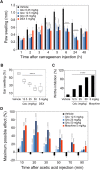One-Step Synthesis of Chiral Oxindole-type Analogues with Potent Anti-inflammatory and Analgesic Activities
- PMID: 26324065
- PMCID: PMC4555174
- DOI: 10.1038/srep13699
One-Step Synthesis of Chiral Oxindole-type Analogues with Potent Anti-inflammatory and Analgesic Activities
Abstract
Here we report a facile approach to synthesize highly optically active oxindole-type analogues with both high yield and enantioselectivity. This single-step synthesis strategy represents a substantial improvement upon existing methods that are often involved with multi-step routes and have suboptimal atomic economy. One such compound, namely Q4c, showed remarkable in vivo anti-inflammatory activity with efficiency approaching to that of a steroidal compound dexamethasone. Moreover, Q4c alleviated pain in mouse models with comparable activity to morphine. Further investigation suggested that nitric oxide signaling pathway is involved in the anti-inflammatory and analgesic activities of Q4c. Notably, this is the first time that chiral oxindole-type analogues have been identified to be both anti-inflammatory and analgesic, and our study also paved the way for future development of oxindoles as drug candidates in this field.
Figures





Similar articles
-
Synthesis, characterization, evaluation and molecular dynamics studies of 5, 6-diphenyl-1,2,4-triazin-3(2H)-one derivatives bearing 5-substituted 1,3,4-oxadiazole as potential anti-inflammatory and analgesic agents.Eur J Med Chem. 2015 Aug 28;101:81-95. doi: 10.1016/j.ejmech.2015.06.020. Epub 2015 Jun 11. Eur J Med Chem. 2015. PMID: 26117820
-
Evaluation of anti-inflammatory and analgesic effects of synthesized derivatives of ibuprofen.Chem Biol Drug Des. 2015 May;85(5):623-32. doi: 10.1111/cbdd.12316. Epub 2014 Jul 16. Chem Biol Drug Des. 2015. PMID: 24618048
-
3-methyl-2-phenyl-1-substituted-indole derivatives as indomethacin analogs: design, synthesis and biological evaluation as potential anti-inflammatory and analgesic agents.J Enzyme Inhib Med Chem. 2016;31(2):318-24. doi: 10.3109/14756366.2015.1022174. Epub 2015 Mar 23. J Enzyme Inhib Med Chem. 2016. PMID: 25798690
-
Pyridazinone: an attractive lead for anti-inflammatory and analgesic drug discovery.Future Med Chem. 2017 Jan;9(1):95-127. doi: 10.4155/fmc-2016-0194. Epub 2016 Dec 13. Future Med Chem. 2017. PMID: 27957866 Review.
-
Quercetin and derivatives: useful tools in inflammation and pain management.Future Med Chem. 2017 Jan;9(1):79-93. doi: 10.4155/fmc-2016-0186. Epub 2016 Dec 20. Future Med Chem. 2017. PMID: 27995808 Review.
Cited by
-
Diastereoselective synthesis of novel spiro indanone fused pyrano[3,2-c]chromene derivatives following hetero-Diels-Alder reaction and in vitro anticancer studies.RSC Adv. 2018 May 8;8(30):16802-16814. doi: 10.1039/c8ra02729c. eCollection 2018 May 3. RSC Adv. 2018. PMID: 35540554 Free PMC article.
-
Iron-Catalyzed Borrowing Hydrogen C-Alkylation of Oxindoles with Alcohols.ChemSusChem. 2019 Jun 7;12(11):2345-2349. doi: 10.1002/cssc.201900799. Epub 2019 May 7. ChemSusChem. 2019. PMID: 30958919 Free PMC article.
-
Anti-inflammatory activity of 3-cinnamoyltribuloside and its metabolomic analysis in LPS-activated RAW 264.7 cells.BMC Complement Med Ther. 2020 Nov 2;20(1):329. doi: 10.1186/s12906-020-03115-y. BMC Complement Med Ther. 2020. PMID: 33138805 Free PMC article.
-
Spiroindolone analogues bearing benzofuran moiety as a selective cyclooxygenase COX-1 with TNF-α and IL-6 inhibitors.Saudi J Biol Sci. 2020 May;27(5):1208-1216. doi: 10.1016/j.sjbs.2020.02.010. Epub 2020 Feb 26. Saudi J Biol Sci. 2020. PMID: 32346326 Free PMC article.
-
Investigating anti-inflammatory and apoptotic actions of fucoidan concentrating on computational and therapeutic applications.3 Biotech. 2023 Nov;13(11):355. doi: 10.1007/s13205-023-03771-0. Epub 2023 Oct 6. 3 Biotech. 2023. PMID: 37810192 Free PMC article.
References
-
- Smith W. L. & Dewitt D. L. Prostaglandin endoperoxide H synthases-1 and -2. Adv. Immunol. 62, 167–215 (1996). - PubMed
-
- Ding K. et al. Structure-based design of potent non-peptide MDM2 inhibitors. J. Am. Chem. Soc. 127, 10130–10131 (2005). - PubMed
-
- Roth S. H. Coming to terms with nonsteroidal anti-inflammatory drug gastropathy. Drugs 72, 873–879 (2012). - PubMed
-
- Marnett L. J. The COXIB experience: a look in the rearview mirror. Annu. Rev. Pharmacol. Toxicol. 49, 265–290 (2009). - PubMed
Publication types
MeSH terms
Substances
LinkOut - more resources
Full Text Sources
Other Literature Sources

